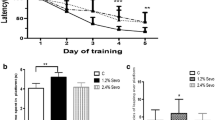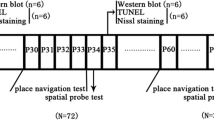Abstract
Sevoflurane is a widely used obstetric general anesthetic, but the neurotoxic effects of late-pregnancy exposure to one minimum alveolar concentration ([MAC], 2.5%) of sevoflurane on offspring remain unclear. We investigated whether exposure to 2.5% sevoflurane during late pregnancy would affect offspring hippocampal neuronal development and neurocognitive function. On gestational day 18 (G18), rats were randomly treated with 2.5% sevoflurane in 50% oxygen for 1 (Sev × 1), 3 (Sev × 3), or 6 h (Sev × 6). The neuronal apoptosis rate and mature brain-derived neurotrophic factor (mBDNF) and postsynaptic density protein 95 (PSD-95) expression levels were measured in offspring hippocampi on postnatal day 1 (P1) and P35. Dendritic spine formation and cognitive function were examined on P35. The neuronal apoptosis rate was enhanced, and mBDNF and PSD-95 levels were reduced in the Sev × 3 and Sev × 6 groups on P1. mBDNF and PSD-95 levels were also decreased in the Sev × 6 group on P35. The error rate was elevated in the maze test, whereas dendritic spine density and long-term potentiation (LTP) were reduced in the Sev × 6 group on P35. To determine whether exposure to an enriched environment (EE) would ameliorate sevoflurane’s neurotoxic effects, offspring from another Sev × 6 group were exposed to either a standard environment (SE) or an EE. Lower error rates and greater dendritic spine densities and LTP were found in the Sev × 6 + EE vs. Sev × 6 + SE group. Collectively, we showed that exposing rats to 1 MAC sevoflurane for 3 h during late pregnancy increased neuronal apoptosis in neonates but did not impair neuronal development or cognitive function in juvenile rats, whereas a 6-h exposure impaired neuronal development and cognitive function in juvenile rats, effects that were attenuated by an EE.




Similar content being viewed by others
References
Amrock LG, Starner ML, Murphy KL, Baxter MG (2015) Long-term effects of single or multiple neonatal sevoflurane exposures on rat hippocampal ultrastructure. Anesthesiology 122(1):87–95. https://doi.org/10.1097/ALN.0000000000000477
Andropoulos DB (2018) Effect of anesthesia on the developing brain: infant and fetus. Fetal Diagn Therapy 43(1):1–11. https://doi.org/10.1159/000475928
Baucum AJ 2nd (2017) Proteomic analysis of postsynaptic protein complexes underlying neuronal plasticity. ACS Chem Neurosci 8(4):689–701. https://doi.org/10.1021/acschemneuro.7b00008
Bhagya VR, Srikumar BN, Veena J, Shankaranarayana Rao BS (2017) Short-term exposure to enriched environment rescues chronic stress-induced impaired hippocampal synaptic plasticity, anxiety, and memory deficits. J Neurosci Res 95(8):1602–1610. https://doi.org/10.1002/jnr.23992
Chidambaram SB, Rathipriya AG, Bolla SR, Bhat A, Ray B, Mahalakshmi AM, Manivasagam T, Thenmozhi AJ, Essa MM, Guillemin GJ, Chandra R, Sakharkar MK (2019) Dendritic spines: revisiting the physiological role. Progr Neuro-psychopharmacol Biol Psychiatry 92:161–193. https://doi.org/10.1016/j.pnpbp.2019.01.005
Chung W, Park S, Hong J, Park S, Lee S, Heo J, Kim D, Ko Y (2015) Sevoflurane exposure during the neonatal period induces long-term memory impairment but not autism-like behaviors. Paediatr Anaesth 25(10):1033–1045. https://doi.org/10.1111/pan.12694
De Tina A, Palanisamy A (2017) General anesthesia during the third trimester: any link to neurocognitive outcomes? Anesthesiol Clin 35(1):69–80. https://doi.org/10.1016/j.anclin.2016.09.007
Fang F, Xue Z, Cang J (2012) Sevoflurane exposure in 7-day-old rats affects neurogenesis, neurodegeneration and neurocognitive function. Neurosci Bull 28(5):499–508. https://doi.org/10.1007/s12264-012-1260-4
Fang F, Song R, Ling X, Peng M, Xue Z, Cang J (2017) Multiple sevoflurane anesthesia in pregnant mice inhibits neurogenesis of fetal hippocampus via repressing transcription factor Pax6. Life Sci 175:16–22. https://doi.org/10.1016/j.lfs.2017.03.003
Gui L, Lei X, Zuo Z (2017) Decrease of glial cell-derived neurotrophic factor contributes to anesthesia- and surgery-induced learning and memory dysfunction in neonatal rats. J Mol Med 95(4):369–379. https://doi.org/10.1007/s00109-017-1521-9
He S, Ma J, Liu N, Yu X (2010) Early enriched environment promotes neonatal GABAergic neurotransmission and accelerates synapse maturation. J Neurosci 30(23):7910–7916. https://doi.org/10.1523/JNEUROSCI.6375-09.2010
Hirase H, Shinohara Y (2014) Transformation of cortical and hippocampal neural circuit by environmental enrichment. Neuroscience 280:282–298. https://doi.org/10.1016/j.neuroscience.2014.09.031
Ibla JC, Hayashi H, Bajic D, Soriano SG (2009) Prolonged exposure to ketamine increases brain derived neurotrophic factor levels in developing rat brains. Curr Drug Saf 4(1):11–16
Ilieva K, Tchekalarova J, Atanasova D, Kortenska L, Atanasova M (2019) Antidepressant agomelatine attenuates behavioral deficits and concomitant pathology observed in streptozotocin-induced model of Alzheimer's disease in male rats. Hormon Behav 107:11–19. https://doi.org/10.1016/j.yhbeh.2018.11.007
Ji MH, Wang XM, Sun XR, Zhang H, Ju LS, Qiu LL, Yang JJ, Jia M, Wu J, Yang J (2015) Environmental enrichment ameliorates neonatal sevoflurane exposure-induced cognitive and synaptic plasticity impairments. J Mol Neurosci 57(3):358–365. https://doi.org/10.1007/s12031-015-0627-1
Ji MH, Wang ZY, Sun XR, Tang H, Zhang H, Jia M, Qiu LL, Zhang GF, Peng YG, Yang JJ (2017) Repeated neonatal sevoflurane exposure-induced developmental delays of parvalbumin interneurons and cognitive impairments are reversed by environmental enrichment. Mol Neurobiol 54(5):3759–3770. https://doi.org/10.1007/s12035-016-9943-xx
Ju LS, Jia M, Sun J, Sun XR, Zhang H, Ji MH, Yang JJ, Wang ZY (2016) Hypermethylation of hippocampal synaptic plasticity-related genes is involved in neonatal sevoflurane exposure-induced cognitive impairments in rats. Neurotox Res 29(2):243–255. https://doi.org/10.1007/s12640-015-9585-1
Li Y, Liang G, Wang S, Meng Q, Wang Q, Wei H (2007) Effects of fetal exposure to isoflurane on postnatal memory and learning in rats. Neuropharmacology 53(8):942–950. https://doi.org/10.1016/j.neuropharm.2007.09.005
Li KA, Lund ET, Voigt JP (2016) The impact of early postnatal environmental enrichment on maternal care and offspring behaviour following weaning. Behav Process 122:51–58. https://doi.org/10.1016/j.beproc.2015.11.008
Li J, Chen J, Ma N, Yan D, Wang Y, Zhao X, Zhang Y, Zhang C (2019) Effects of corticosterone on the expression of mature brain-derived neurotrophic factor (mBDNF) and proBDNF in the hippocampal dentate gyrus. Behav Brain Res 365:150–156. https://doi.org/10.1016/j.bbr.2019.03.010
Lu Y, Huang Y, Jiang J, Hu R, Yang Y, Jiang H, Yan J (2016) Neuronal apoptosis may not contribute to the long-term cognitive dysfunction induced by a brief exposure to 2% sevoflurane in developing rats. Biomed Pharmacother 78:322–328. https://doi.org/10.1016/j.biopha.2016.01.034
Lu CQ, Zhong L, Yan CH, Tian Y, Shen XM (2017) Effects of preweaning environmental enrichment on hippocampus-dependent learning and memory in developing rats. Neurosci Lett 640(117–1):22. https://doi.org/10.1016/j.neulet.2016.12.053
Luo F, Hu Y, Zhao W, Zuo Z, Yu Q, Liu Z, Lin J, Feng Y, Li B, Wu L, Xu L (2016) Maternal exposure of rats to isoflurane during late pregnancy impairs spatial learning and memory in the offspring by up-regulating the expression of histone deacetylase 2. PLoS ONE 11(8):e0160826. https://doi.org/10.1371/journal.pone.0160826
Lv X, Yan J, Jiang J, Zhou X, Lu Y, Jiang H (2017) MicroRNA-27a-3p suppression of peroxisome proliferator-activated receptor-gamma contributes to cognitive impairments resulting from sevoflurane treatment. J Neurochem 143(3):306–319. https://doi.org/10.1111/jnc.14208
Mahati K, Bhagya V, Christofer T, Sneha A, Shankaranarayana Rao BS (2016) Enriched environment ameliorates depression-induced cognitive deficits and restores abnormal hippocampal synaptic plasticity. Neurobiol Learn Mem 134(Pt B):379–391. https://doi.org/10.1016/j.nlm.2016.08.017
McLeod F, Marzo A, Podpolny M, Galli S, Salinas P (2017) Evaluation of synapse density in hippocampal rodent brain slices. J Vis Exp. https://doi.org/10.3791/56153
Nieto R, Kukuljan M, Silva H (2013) BDNF and schizophrenia: from neurodevelopment to neuronal plasticity, learning, and memory. Front Psychiatry 4:45. https://doi.org/10.3389/fpsyt.2013.00045
Nithianantharajah J, Hannan AJ (2006) Enriched environments, experience-dependent plasticity and disorders of the nervous system. Nat Rev Neurosci 7(9):697–709. https://doi.org/10.1038/nrn1970
Noguchi KK, Johnson SA, Dissen GA, Martin LD, Manzella FM, Schenning KJ, Olney JW, Brambrink AM (2017) Isoflurane exposure for three hours triggers apoptotic cell death in neonatal macaque brain. Br J Anaesth 119(3):524–531. https://doi.org/10.1093/bja/aex123
Olutoye OA, Baker BW, Belfort MA, Olutoye OO (2018) Food and Drug Administration warning on anesthesia and brain development: implications for obstetric and fetal surgery. Am J Obstet Gynecol 218(1):98–102. https://doi.org/10.1016/j.ajog.2017.08.107
Park H, Poo MM (2013) Neurotrophin regulation of neural circuit development and function. Nat Rev Neurosci 14(1):7–23. https://doi.org/10.1038/nrn3379
Sen A, Nelson TJ, Alkon DL (2017) ApoE isoforms differentially regulates cleavage and secretion of BDNF. Mol Brain 10(1):19. https://doi.org/10.1186/s13041-017-0301-3
Servick K (2014) Biomedical research. Researchers struggle to gauge risks of childhood anesthesia. Science 346(6214):1161–1162. https://doi.org/10.1126/science.346.6214.1161
Shan Y, Sun S, Yang F, Shang N, Liu H (2018) Dexmedetomidine protects the developing rat brain against the neurotoxicity wrought by sevoflurane: role of autophagy and Drp1-Bax signaling. Drug Des Dev Therapy 12:3617–3624. https://doi.org/10.2147/DDDT.S180343
Shen FY, Song YC, Guo F, Xu ZD, Li Q, Zhang B, Ma YQ, Zhang YQ, Lin R, Li Y, Liu ZQ (2018) Cognitive impairment and endoplasmic reticulum stress induced by repeated short-term sevoflurane exposure in early life of rats. Front Psychiatry 9:332. https://doi.org/10.3389/fpsyt.2018.00332
Shih J, May LD, Gonzalez HE, Lee EW, Alvi RS, Sall JW, Rau V, Bickler PE, Lalchandani GR, Yusupova M, Woodward E, Kang H, Wilk AJ, Carlston CM, Mendoza MV, Guggenheim JN, Schaefer M, Rowe AM, Stratmann G (2012) Delayed environmental enrichment reverses sevoflurane-induced memory impairment in rats. Anesthesiology 116(3):586–602. https://doi.org/10.1097/ALN.0b013e318247564d
Song R, Ling X, Peng M, Xue Z, Cang J, Fang F (2017) Maternal sevoflurane exposure causes abnormal development of fetal prefrontal cortex and induces cognitive dysfunction in offspring. Stem Cells Int 2017:6158468. https://doi.org/10.1155/2017/6158468
Suehara T, Morishita J, Ueki M, Ueno M, Maekawa N, Mizobuchi S (2016) Effects of sevoflurane exposure during late pregnancy on brain development of offspring mice. Paediatr Anaesth 26(1):52–59. https://doi.org/10.1111/pan.12785
Tian Y, Chen KY, Liu LD, Dong YX, Zhao P, Guo SB (2018) Sevoflurane exacerbates cognitive impairment induced by abeta 1–40 in rats through initiating neurotoxicity, neuroinflammation, and neuronal apoptosis in rat hippocampus. Mediat Inflamm 2018:3802324. https://doi.org/10.1155/2018/3802324
Titley HK, Brunel N, Hansel C (2017) Toward a neurocentric view of learning. Neuron 95(1):19–32. https://doi.org/10.1016/j.neuron.2017.05.021
Wang S, Peretich K, Zhao Y, Liang G, Meng Q, Wei H (2009) Anesthesia-induced neurodegeneration in fetal rat brains. Pediatr Res 66(4):435–440. https://doi.org/10.1203/PDR.0b013e3181b3381b
Wu Z, Li X, Zhang Y, Tong D, Wang L, Zhao P (2018) Effects of sevoflurane exposure during mid-pregnancy on learning and memory in offspring rats: beneficial effects of maternal exercise. Front Cell Neurosci 12:122. https://doi.org/10.3389/fncel.2018.00122
Xu H, Baracskay P, O'Neill J, Csicsvari J (2019) Assembly responses of hippocampal CA1 place cells predict learned behavior in goal-directed spatial tasks on the radial eight-arm maze. Neuron 101(1):119–132. https://doi.org/10.1016/j.neuron.2018.11.015
Yeh CM, Huang CC, Hsu KS (2012) Prenatal stress alters hippocampal synaptic plasticity in young rat offspring through preventing the proteolytic conversion of pro-brain-derived neurotrophic factor (BDNF) to mature BDNF. J Physiol 590(4):991–1010. https://doi.org/10.1113/jphysiol.2011.222042
Zhang J, Dong Y, Zhou C, Zhang Y, Xie Z (2015) Anesthetic sevoflurane reduces levels of hippocalcin and postsynaptic density protein 95. Mol Neurobiol 51(3):853–863. https://doi.org/10.1007/s12035-014-8746-1
Zhao Y, Chen K, Shen X (2015) Environmental enrichment attenuated sevoflurane-induced neurotoxicity through the PPAR-gamma signaling pathway. BioMed Res Int 2015:107149. https://doi.org/10.1155/2015/107149
Zheng H, Dong Y, Xu Z, Crosby G, Culley DJ, Zhang Y, Xie Z (2013) Sevoflurane anesthesia in pregnant mice induces neurotoxicity in fetal and offspring mice. Anesthesiology 118(3):516–526. https://doi.org/10.1097/ALN.0b013e3182834d5d
Zhou Q, Homma KJ, Poo MM (2004) Shrinkage of dendritic spines associated with long-term depression of hippocampal synapses. Neuron 44(5):749–757. https://doi.org/10.1016/j.neuron.2004.11.011
Zhou X, da Li W, Yuan BL, Niu LJ, Yang XY, Zhou ZB, Chen XH, Feng X (2016) Lithium treatment prevents apoptosis in neonatal rat hippocampus resulting from sevoflurane exposure. Neurochem Res 41(8):1993–2005. https://doi.org/10.1007/s11064-016-1909-x
Acknowledgements
We thank Yuhua Cui for her assistance in designing of the figures.
Funding
This work was supported by grants from the National Natural Science Foundation of China [Grant No. 81571054] and Tianjin Major Support Program of Science and Technology [Grant No. 18YFZCSY00530].
Author information
Authors and Affiliations
Contributions
All authors have made substantive intellectual contributions to the manuscript. ZY and HW designed the study. JW and JW were responsible for conducting the study and analyzing the data. ZY and PZ wrote the manuscript. JC revised the manuscript. All authors have seen the original study data, reviewed the data analysis, and approved the final manuscript.
Corresponding author
Ethics declarations
Conflicts of interest
All authors declare that there is no conflict of interest.
Ethical Approval
All procedures involving animals in this study were performed in accordance with the Regulations for Research at the Tianjin Medical University and with the approval of the local Animal Care Committee.
Additional information
Publisher's Note
Springer Nature remains neutral with regard to jurisdictional claims in published maps and institutional affiliations.
Electronic supplementary material
Below is the link to the electronic supplementary material.
Rights and permissions
About this article
Cite this article
Yu, Z., Wang, J., Wang, H. et al. Effects of Sevoflurane Exposure During Late Pregnancy on Brain Development and Beneficial Effects of Enriched Environment on Offspring Cognition. Cell Mol Neurobiol 40, 1339–1352 (2020). https://doi.org/10.1007/s10571-020-00821-6
Received:
Accepted:
Published:
Issue Date:
DOI: https://doi.org/10.1007/s10571-020-00821-6




